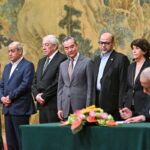As its global image takes a big hit, the Chinese Communist Party is using an arsenal of spin, obfuscation, hyperbole, and outright disinformation to win back its reputation.
It was posed as an innocent question, not an accusation. If the U.S. was so concerned about transparency, China’s Foreign Ministry spokesperson Hua Chunying wondered aloud to nearly half a million followers on Twitter earlier this month, why not open its own biodefense lab in Maryland’s Fort Detrick to international inspectors?
Hua’s tweet was also an invitation to a conspiracy theory, and a message that, if President Donald Trump was determined to speculate about the virus first appearing in a Chinese lab—a notion that scientists have dismissed and that allied intelligence agencies find “highly unlikely”—then China was going to give as good as it got. Beijing does not accept that the virus originated in China at all, insisting that just because the country first reported the virus, and traced many of the first cases to an outdoor market in Wuhan, doesn’t mean it came from there. What if, Hua intimated without quite saying, it came from a U.S. lab instead?
After that May 8 tweet, Chinese state media outlets picked up the question and started pushing it in multiple languages: Spanish and Arabic as well as English. On May 12, the state-run China Global Television Network offered a story on the Fort Detrick lab’s “purely freakish history,” including the very real CIA experiments on humans that began there in the 1950s. The hawkish Communist Party newspaper Global Times ran a piece on May 14 declaring, “The US can’t just claim all reasonable inquiries to its bio-labs as ‘conspiracy theories.’” This followed the paper’s earlier speculation, citing a mysterious anonymous petition on the White House website, that the base may have been the source of a virus leak.
This was a bizarre salvo in China’s propaganda war with the United States over the coronavirus, and it showcased Beijing’s latest information weaponry. Misleading spin, obfuscation, concealment, and hyperbole have been hallmarks of the Chinese Communist Party’s propaganda campaign, before and during the coronavirus era. But the pandemic appears to have given rise to more forceful attacks on foreign governments, as well as a new level of flirtation with outright disinformation.
Thomas Wright: How should Biden handle China?
The party has never waged a global struggle quite like this one—and its battle with the U.S. over where the virus came from and whose failures made the pandemic worse have marked a serious deterioration in the two countries’ ties. Just months ago, Trump was praising Xi Jinping for how he handled the outbreak; now Trump is toying with cutting off relations with the Chinese government altogether.
Seven decades ago, Mao Zedong publicly embraced a benevolent view of propaganda, as if he were a latter-day prophet spreading the communist gospel: “We should carry on constant propaganda among the people on the facts of world progress and the bright future ahead so that they will build their confidence in victory,” he mused in 1945. Just a few months ago, Xi Jinping urged state journalists to spread “positive propaganda” for the “correct guidance of public opinion.” Indeed, Beijing’s global propaganda efforts in recent years have been more about promoting China’s virtues than about spreading acrimony and confusion, à la Russian information ops and election meddling. Moscow wants a weakened and divided West, one that leaves Russia free to dominate its self-appointed sphere of influence—but Russia in 2016 was also an economically sluggish, oil-dependent nation with an economy a tenth the size of America’s, and lacked the resources to remake the world in its image.
Beijing has a much bigger prize in mind and a much longer-term plan to get it: The contest isn’t about who gets to run the U.S. It’s about who deserves to run the world. And China, with its economy poised to overtake that of the United States, has already plowed billions into crafting an image as a responsible global leader, and billions more into cultivating global dependence on Chinese investments and Chinese markets.
“While the [Chinese Communist Party] has long sought to be a global influencer, their efforts today are aggressive and sophisticated,” Bill Evanina, the director of the National Counterintelligence and Security Center, wrote in an email. “In short, they’re looking to reshape the history of coronavirus and protect their reputation at home and around the world.”
Before the coronavirus hit, the party was becoming bolder in its propaganda efforts overseas as China grew richer and more powerful, trying to promote around the world the orthodoxy it enforced at home, about the beneficence and goodness of the CCP. This involved publicizing Chinese investments in the developing world, arm-twisting diplomats to toe a pro-China line, ruthlessly trying to stifle even other countries’ freedom to dissent—to the point of sanctioning Norway in 2010 when the Norwegian Nobel Committee awarded its peace prize to the imprisoned democracy activist Liu Xiaobo, who died in 2017. Xi has elevated the role of propaganda even further as he has vowed to build China’s power and prosperity, declaring, “The superiority of our system will be fully demonstrated through a brighter future.”
The coronavirus outbreak and the global outcry against China’s failures of transparency and containment were not part of the plan. They sparked an international backlash that, by Beijing’s reported reckoning, was worse than anything it had faced since the Tiananmen Square massacre in 1989. So Beijing leaped to seize, or at least confuse, the global story of the virus and its cast of heroes and villains.
This has involved unleashing techniques Russia perfected during the U.S. presidential election in 2016. “We’ve seen China adopt Russian-style social media manipulation tactics like using bots and trolls to amplify disinformation on COVID-19,” Lea Gabrielle, the special envoy and coordinator for the State Department’s Global Engagement Center, wrote to me in an email. “Both countries repress information within their countries while taking advantage of the open and free information environments in democracies to push conspiracy theories that seek to undermine those environments.”
As the world realized the virus was spreading out of control, Chinese diplomats, official media, and Twitter influencers launched an aggressive frenzy of defense, scrambling to preserve the Chinese Communist Party’s cratering reputation at home and overseas. And then they went on offense, with an assist from perhaps thousands of fake or hacked Twitter accounts, according to the investigative site ProPublica. The result was a coordinated campaign of attacks on the United States, and the spread of disinformation and confusion about where the virus really came from and whose screwup it was, really, that led to so much death.
Read: America’s patchwork pandemic is fraying even further
Other countries’ faltering responses to the virus have only bolstered this narrative, and the CCP has gleefully trumpeted America’s failures in particular. “Loose political system in the US allows more than 4000 people to die of pandemic every day,” Hu Xijin, the editor in chief of the Global Times newspaper, tweeted in April. “Americans are so good tempered.” Beyond the immediate crisis, this kind of narrative also serves the longer-term goal. In the words of Matt Schrader, a former China analyst with the Alliance for Securing Democracy at the German Marshall Fund: “Ultimately it’s about the [Chinese Communist Party] being the most powerful political entity on the planet.”
The CCP has evolved in its themes and tactics over the course of the coronavirus information war so far, as it battles to bolster its own reputation and degrade that of the United States. The campaign has been widespread and highly focused at the same time. And the party has grown even more emboldened in the belief that it’s too big to fail, and that the reeling world may condemn it but still depends on it.
Suppression and celebration
Even more important than what the Chinese Communist Party says is what it doesn’t say. The party is such an aggressive suppressor of negative news that at one point government censors tried to block social-media references to Winnie the Pooh—because whimsical Chinese netizens had seized on the pudgy cartoon bear’s purported resemblance to Xi. The Central Propaganda Department distributes guidelines to media organizations and scrubs microblogging platforms for references to the widespread abuses of Uighur Muslims in Xinjiang and to hopes for autonomy in Tibet.
So “relatively open” online discussions of the virus in late January, according to a report by the Freedom House China analyst Sarah Cook, seemed almost out of character. “Professional journalists took advantage of the government’s slow response to publish reports on the early days of the outbreak and life under the dramatic lockdown of numerous cities in China.” The party’s flagship paper, the People’s Daily, however, had largely ignored the gathering virus up until that point, Cook notes; back then it was covering the U.S. House and Senate impeachment votes on Trump and the U.S. strike against the Iranian General Qassem Soleimani. And China had already waged perhaps the most dangerous information-suppression campaign of the entire crisis—reprimanding doctors who tried to warn one another about the disease, blocking reports about sickened health-care workers, and ordering labs to destroy samples.
The coronavirus killed one of those doctors, Li Wenliang, in early February, prompting an outpouring of grief and outrage on Chinese social media. What openness there had been was over. “Less than 90 minutes after his death on Friday morning, the hashtag ‘I want freedom of speech’ was trending on Weibo, a popular Chinese blogging site, with nearly 2 million posts,” wrote NPR’s Emily Feng and Amy Cheng. “The posts were gone by sunrise.”
At the same time that Chinese authorities were pulling down criticism, they were pushing out praise for first responders. State media published stories about robots delivering food, factory employees giving up their holidays to make masks, a nurse shaving her head to speed up the process of putting on protective gear. The People’s Daily ran a love letter to the city of Wuhan, titled “Heroic City, Heroic People”: “Our hospitals have become the battlefield!,” reads a partial translation by the China Media Project. Of the medical workers who had rushed to Wuhan from around the country, it noted: ”In order to not impact the flow of their work, some doctors and nurses wore adult diapers … Their white outfits are war fatigues, and they are the most beautiful resisters, the most adorable people of the New Era!”
Cook traces how the narrative began to shift into February, accruing credit to the Communist Party’s own actions and then, ultimately, turning attention to the rest of the world as the coronavirus slammed into other countries. Xiao Qiang, a research scientist at the School of Information at UC Berkeley, told me that the party’s line about other countries’ response was essentially: “They couldn’t handle it either.” The government version of events became that China had handled the outbreak well by comparison, and had a lot to teach the world about it. In March, the government dispatched aid to virus-ravaged Italy at a time when the European Union would not step in, and state-run papers published pictures of the team arriving along with quotes of gratitude from Italian officials.
Before the month was out, Chinese state media was suggesting that the virus may have originated in Italy instead—an early effort to flood the world with confusion about where the virus came from.
The counterpunch
As the message was shifting, one tactic remained consistent: Pump up the seeming good news about the party and suppress the bad. In March came the expulsion of American journalists working for The New York Times, The Wall Street Journal, and The Washington Post, which China’s Foreign Ministry characterized as a response to U.S. restrictions on Chinese media acting on behalf of a foreign government. (One senior State Department official told reporters, while announcing the new restrictions in February: “We think it’s altogether appropriate that we basically call these entities what they are, which are organs of the Chinese one-party state propaganda apparatus.”)
By mid-April, diplomats and state media were focused on rising infection rates in the United States and the United Kingdom. Hua, the Foreign Ministry spokesperson, pointed out on April 12 that the U.S. then led the world in infections and deaths, despite having been warned in early January about the situation in Wuhan. State broadcasters highlighted praise for China’s early response from the World Health Organization, right as Trump was swiping at the agency for its criticism of the U.S. and complaining that the organization seemed “to always err on the side of China.”
Read: How China deceived the WHO
The most aggressive trolling came in video form. The state-run news agency Xinhua’s “Once Upon a Virus” featured animated Legos—a set of responsible, masked Chinese ones trying to warn a recalcitrant Lego Statue of Liberty that people needed to take the virus seriously and wear masks. After dismissing the warnings, the Lego Liberty turns red with rage and ends up on an intravenous drip, whining, “Why didn’t you warn us?” The Chinese embassy in France tweeted the video, which racked up more than 15,000 retweets. Graham Brookie, the director and managing editor of the Atlantic Council’s Digital Forensic Research Lab, wrote to me in an email that it was fair to say the tweet was “targeted towards the Western world,” and specifically Europe. Brookie noted that a small portion of the video’s Twitter spread was aided by accounts with Western-sounding names, such as “Emily Clark,” and “bot-like indicators”—ones that were recently created, or had handles involving a first name and a scramble of numbers, or lacked profile pictures, or whose sole tweet was the Lego video. “All retweeted the China Xinhua News’ tweet with the same copy-and-pasted text,” he wrote.
Another video put the narrative in even more explicit terms, presenting America as not merely hapless but in outright decline. The United States has now seen 100,000 deaths attributable to the virus, while China has claimed only about 5,000, though U.S. intelligence officials believe China is far underreporting its numbers. The state-owned China Global Television network pronounced the virus “Waterloo for America’s leadership,” as a British-accented announcer intoned, over shots of the Capitol building and homeless people gathered in a parking lot: “An increasing number of observers are beginning to see that the health emergency is signaling the end of the American century … There is growing evidence that Washington is tumbling to rock bottom over its coronavirus response.”
The conspiracy
Perhaps the most surprising new feature of China’s coronavirus propaganda effort has been the dabbling in Russian-style disinformation. Nowhere has this been clearer than in prominent government officials’ efforts to obscure the origins of the virus, floating the baseless theories that the U.S. Army might have brought the disease to Wuhan, or that maybe it started in Italy. Sometimes these weren’t so much pure “fake news” plants as they were the “people are saying” variety of misdirection that has become a hallmark of how Trump’s White House deals with criticism.
Some of these types of attacks appeared to be experiments and have since faded. Gabrielle, the State Department special envoy, said at a press conference in March that Chinese officials in Africa briefly pushed a U.S.-origin theory of the virus, but then “abandoned that disinformation campaign” after receiving mostly negative online reactions. Elsewhere, Gabrielle wrote to me, Beijing backed off from directly attributing the virus to the U.S. “But we continue to see CCP propaganda like CGTN push content that suggests the U.S. is the origin of the virus. The [Ministry of Foreign Affairs] is still citing conspiracy websites in its messaging.”
Hence the Fort Detrick tweets from the foreign ministry, which never directly say the U.S. bio lab cooked up the virus, but darkly hint that there may be something there to investigate.
Economic coercion and diplomatic arm-twisting
When all else fails—when hints on Twitter just don’t seem to cut it—Beijing can rely on its economic power to try to coerce kindness from foreign officials or stifle their criticism. This has two benefits relative to China’s domestic audience: Praise can be trumpeted as evidence that China is respected around the world, while criticism can be used to stoke nationalist defensiveness in the face of politicians seen as unfairly targeting China.
When Australian Prime Minister Scott Morrison called for an independent investigation into the origins of the virus, China’s ambassador to Australia lashed out, pronouncing the Chinese public to be “frustrated, dismayed, and disappointed” and launching into some hypotheticals in the vein of nice trading relationship—would be a shame if anything happened to it. “The tourists,” said Ambassador Cheng Jingye in an interview with the Australian Financial Review, “may have second thoughts.” (More than 1 million people visit Australia from China every year, more tourists than visit from any other country.) “Maybe the parents of the students would also think whether this place, which they find is not so friendly, even hostile, is the best place to send their kids to … And also, maybe the ordinary people will think why they should drink Australian wine or eat Australian beef.” The implications for a country that relies on trade with China were hard to miss. Australia has continued to push for the inquiry.
China then started restricting some Australian meat imports, imposed tariffs on barley, and, according to Bloomberg, is considering targeting wine and dairy.
Beijing has even reportedly pressured foreign officials not to criticize its own use of disinformation. The Financial Times reported that Chinese officials complained to the European Union three times right before the bloc released a report on disinformation in the pandemic—and the published report removed a sentence in an earlier draft saying that China was running a “global disinformation campaign to deflect blame.” The EU’s top diplomat denied having bowed to any pressure, but one EU disinformation analyst aware of the changes accused EU diplomats of “self-censoring to appease the Chinese Communist Party.” It’s unclear what specific threats, if any, Chinese officials made, though China and the European Union are among each other’s largest trading partners.
Read: China’s bargain on global influence is paying off
But the biggest battle is between the United States and China, particularly as the U.S. struggles to stabilize its death toll and has appeared disinterested in leading a global response—for example sitting out an EU-led fundraising conference for a vaccine to which China sent a low-level representative. China has made ostentatious pledges of cash to the WHO as the U.S. has paused its funding, and Beijing has vowed to offer any vaccine discoveries from Chinese scientists as a global public good.
In Washington, officials and lawmakers are demanding some unspecified form of accountability from China and concocting ways to pull some manufacturing back to the United States, while demanding investigations into the virus’s origins. Chinese state media outlets characterize Trump’s blaming China as a deflection of responsibility for his own government’s failures—but just because it’s propaganda doesn’t mean it’s false. “What I see is a race to the bottom with China,” Susan Shirk, the chair of the 21st-Century China Center at UC San Diego, told me. “The cost of this is more people are going to die. More people are going to die because the two biggest economies in the world are not going to put their disputes aside to get the world to work together to confront this pandemic.”
The longer-term implications stretch far beyond the immediate crisis, however. When it’s all over, China will have gained experience pushing its propaganda overseas at a volume and intensity it never had before. The CCP has succeeded at home, through rigorous information management, in controlling what Schrader, the former German Marshall Fund scholar, calls the “means of perception.” And the party is having some success extending those tools beyond its borders. “Controlling the means of perception is fundamental to power,” Schrader said. And the better China’s propaganda works, the more power it will have to shape the rest of the world.
















